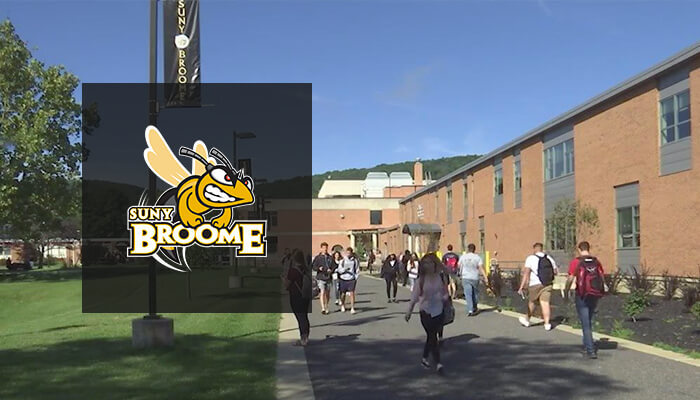
SUNY Broome Sees 3.7% Registration Increase with Data-Activated Enrollment Management
Share this Post
The Challenge: Confronted with plateaued student outcomes, change was needed to assess the complete student picture and have the right tools to support them holistically.
The Strategy: Implement student success technology to generate actionable insights, improve visibility, and create workflow efficiencies to lift enrollment, retention, and graduation rates.
The Outcomes: Streamlined platform lifts enrollment, cultivates collaboration between faculty and staff, and informs strategic investment decisions based on measurable impact on institutional goals.
As part of the State University of New York (SUNY), the country’s largest integrated public higher education system, SUNY Broome Community College is committed to giving everyone a chance at success. Its 5,468 enrolled students come from a diverse population surrounding Broome County and extends throughout New York. However, like many institutions, it faced challenges in boosting enrollment, retention, and completion rates.
The launch of their 2023-2027 Strategic Enrollment Management Plan prompted SUNY Broome to revitalize its approach, adopting a more unified, case management-oriented model and engaging faculty in the process. Teaming up with Civitas Learning provided them with real-time insights and connected workflow tools to prioritize assistance, guide individuals to resources, and assess the effectiveness of their initiatives.
Investing in technology to address enrollment and retention rates has helped SUNY Broome clarify who needs assistance and why, eliminating the guesswork and uncertainty from their daily outreach and planning efforts. Their work has already resulted in enrollment improvements and significant enhancements in how faculty and advisors work together.
Challenge: Identify Enrollment and Retention Barriers to Boost Student Outcomes
Despite continuous investments to improve student outcomes, SUNY Broome faced a significant challenge as enrollment and retention rates continued to decline. From 2016 to 2022, the total Fall headcount decreased by 25%, and retention and graduation rates told a similar story. Fall-to-spring retention rates stood at 78.4%, while fall-to-fall retention rates were 47.90%. These declines had a ripple effect on graduation rates, averaging 16% for two-year completion and 26% for four-year completion.
The institution’s 2023-2027 Strategic Enrollment Management Plan placed this challenge front and center. The first two goals prioritized enrollment and retention. By 2027, the plan aimed to boost Full-Time Enrollment by 250 students and elevate the institutional retention rate by 5%, reaching a minimum of 57.5%.
To achieve these goals, it was imperative to improve access to student information and facilitate seamless communication and collaboration between teams – specifically faculty and staff who faced challenges sharing student information. Faced with supporting caseloads of up to 250 students per advisor, they needed to easily pinpoint student groups needing support.
SUNY Broome sought to address student needs by offering targeted support, enhancing collaboration and information sharing, and achieving student outcomes aligned with the goals outlined in the strategic plan.
Strategy: Implement a Multipronged Approach with Campus-Wide Engagement and Actionable Insights
Tackling these barriers required more than a quick fix. It called for improved access to information, integrated systems for seamlessly gathering insights, and furthering collaboration across the entire institution.
By teaming up with Civitas Learning, SUNY Broome has adopted a holistic, data-activated strategy that allows them to connect the dots and see the complete student picture, instead of relying solely on their advising interactions. Here’s a peek into how the institution has revitalized its approach and is pushing forward in the months ahead.
- Proactive Advising Model Supports Guided Pathways Initiative
Advising is often considered the most powerful tool to improve student outcomes. Driven by principles from The SUNY Guided Pathways Project, SUNY Broome revamped its approach to incorporate case management and individualized support. Previously, students would drop in and receive support from whoever was available, making it challenging to track their progress on different platforms and follow up with resources. The Student Success Team needed a way to document information and activity, as well as efficiently monitor progress to ensure students stay on track toward their degree completion.
Civitas Learning’s Advising Analytics and Workflow solution empowers advisors with predictive capabilities, allowing them to identify groups of students needing support and track their progress over time. They can target specific groups, such as first-time college students who haven’t met with an advisor or those with alerts from multiple faculty members. This actionable intelligence ensures personalized support is proactively provided, enabling advisors to adjust interventions in real-time rather than waiting until the end of the term.

“Unlike traditional ways of analyzing when the term ends, [with Civitas Learning] our approach allows us to make ongoing adjustments in real-time. This enables us to allocate resources more effectively, both in terms of money and time.”
—Dr. Kimberly McLain,
Associate Vice President/Dean of Health Sciences and Institutional Effectiveness
The solution’s Early Alert system allows faculty and advisors to share information and draft messages based on the needs of each student group. Advisors can assess faculty alerts in the context of other success metrics to evaluate a complete picture of the student’s situation – such as LMS engagement relative to peers, in-progress grades, persistence and completion predictions, advising notes, and previous alerts.
Having a complete student profile makes it easier to provide personalized, relevant recommendations and resources. It also saves advisors valuable time that they previously spent tracking down information and figuring out the right course of action.
Is Your Early Alert System Doing More Harm Than Good?
- Connected Student Success Platform Enables Proactive Support at Scale
Knowing who to support and what is in their way can seem like a pipe dream to advisors faced with an overwhelming list of projects and student requests. The Advising Analytics and Workflow solution is backed by AI-powered predictive analytics, making it easier to initiate proactive outreach and provide support at scale. With all student information stored in one platform, SUNY Broome was able to:
Target Student Groups and Scale Support — Advisors can filter their caseload by student persistence prediction scores, signaling who is most (or least) likely to continue and recommend engagement strategies. For instance, the platform flagged 184 students on academic warning and financial aid, initiating targeted outreach campaigns and encouraging them to connect with a student success coach or advisor. Advisors can enhance effectiveness and drive overall outcomes by tailoring support to specific targeted groups.

“The biggest thing we’ve benefited from was really looking at those predictive factors and what kind of interventions we need for various groups. We’re rolling it out to small groups and having specific interventions – it’s probably the most positive thing we’ve done so far.”
—Dr. Penny Kelly,
Vice Presient of Academic Affairs, SUNY Broome Community College
Implement Change Management Strategies to Engage Faculty — Successfully targeting student groups hinges on having shared access to information. However, departmental silos and limited communication between faculty and staff hindered student support efforts. Recognizing the vital role of faculty, administrators implemented creative strategies to secure buy-in. These included offering financial incentives from grant funding, establishing a faculty mentor model, and forming diverse working groups that promoted shared decision-making.
Refine Strategies During the Term with Real-Time Data — Offering real-time, institution-specific insights, the Civitas Learning Student Impact Platform empowers leaders to make informed decisions and refine strategies. Faculty, advisors, and administrators collaborate seamlessly with a shared view of student notes, connecting previously isolated information. Student-facing teams also benefit from these insights and share that these changes have bolstered enrollment and enhanced advisor-student relationships.
- Course Insights to Identify Underlying Barriers to Success
SUNY Broome took a step back to identify any systemic barriers hindering student persistence, aiming to stop the trend of enrollment declines. Leveraging Civitas Learning’s Course Insights, they identified courses that harmed persistence and graduation rates. These insights also spotlight the demographics and majors of students enrolled, empowering advisors and administrators to anticipate needs and allocate resources proactively.
They identified the top 10 most challenging courses with the highest DFW (drop, fail, or withdrawal) rates. Data surfaced that 45% of their population had at least one DFW on their record, which signaled that they needed to provide additional support to those enrolled in ‘high-risk’ courses. This led to the implementation of various support tactics, such as:
- Weekly outreach from Success Coaches targeted at students enrolled in 2 or more high DFW courses
- Student success strategies provided by Success Coaches, includes study strategies, time management, and syllabus review during help desk hours
- Increased Supplemental Instruction added to courses identified as having high DFW rates
With data-driven insights backing their strategy, advisors and success coaches have a compelling story to tell when advocating for additional resources. This proactive approach allows them to plan ahead for future terms, ensuring they have the necessary support to improve outcomes in high-risk courses.
- Simplified Academic Planning and Student Scheduling
Moving from one system to the next to complete registration is time consuming and leaves room for error. SUNY Broome received feedback from a student survey that many students found the registration process overwhelming and needed help understanding what was essential to fulfill degree requirements. The lack of clarity led to students taking unnecessary courses, hindering degree progress and affecting enrollment and retention. The Strategic Enrollment Team needed a solution to streamline efforts and improve access to advisors.
Civitas Learning’s Academic Planning and Student Scheduling allows students to plan, schedule, and register in the same experience. It also helps administrators better understand what courses and resources students need since they have access to courses students plan to take in future terms. Students can personalize their plans, view progress toward their degree, and select courses directly from their academic plan. This ability clarifies the steps needed to progress toward their degree and saves time previously spent moving between systems, and ensures the correct information is carried over.
From here, students generate conflict-free schedules factoring in preferences and breaks and register all in the same experience. Although early in its adoption, SUNY Broome has already observed a 3.7% increase in registration from Fall 2022 to Spring 2024.
Outcomes: Proactive Advising Model Improves Enrollment and Campus-Wide Collaboration
SUNY Broome’s collaboration with Civitas Learning has facilitated a more focused, intentional approach. Embracing a proactive and holistic care model, they are advancing the student experience and eliminating obstacles.
With access to information and centralized workflow tools to collaborate and capture new information, faculty and staff can effectively align their efforts with institutional enrollment goals. While in the initial stages of this approach, SUNY Broome has experienced some early wins:
- Streamlined Planning and Registration — Registration rates are up 3.7% from Fall 2022 to Spring 2024 after implementing an end-to-end planning, scheduling, and registration experience.
- Capacity to Deliver Proactive Support at Scale — Using predictive analytics to prioritize who needs help and why, they can remove the guesswork from daily planning and pull information together for more targeted communication and engagement
- Higher Engagement Among Faculty — Thoughtful change management strategies have led to a more engaged faculty, making it easier for students to get the support they need to persist. Shared access to student information provides more holistic, relationship-focused support.
- Improved Cross-functional Collaboration—With working groups bringing faculty and staff together, coupled with streamlined systems for surfacing actionable insights and facilitating communication through scheduling, messaging, and early alert capabilities, SUNY Broome is well-positioned for improved outcomes.
- Proactive Support for High Risk Courses — Civitas Learning’s Course Insights feature uncovered the top 10 courses most likely to result in a DFW outcome. They can provide proactive support to those enrolled and keep them progressing toward completion.
- Multi-Faceted Approach to Proactively Address Barriers — Along with student-facing teams, administrators benefit from institutional insights negatively impacting student success, such as uncovering the top 10 courses most likely to result in a DFW outcome
For more information on how a connected platform, integrating advising, scheduling, planning, and initiative analytics, helps improve outcomes, check out Civitas Learning’s solution here.


